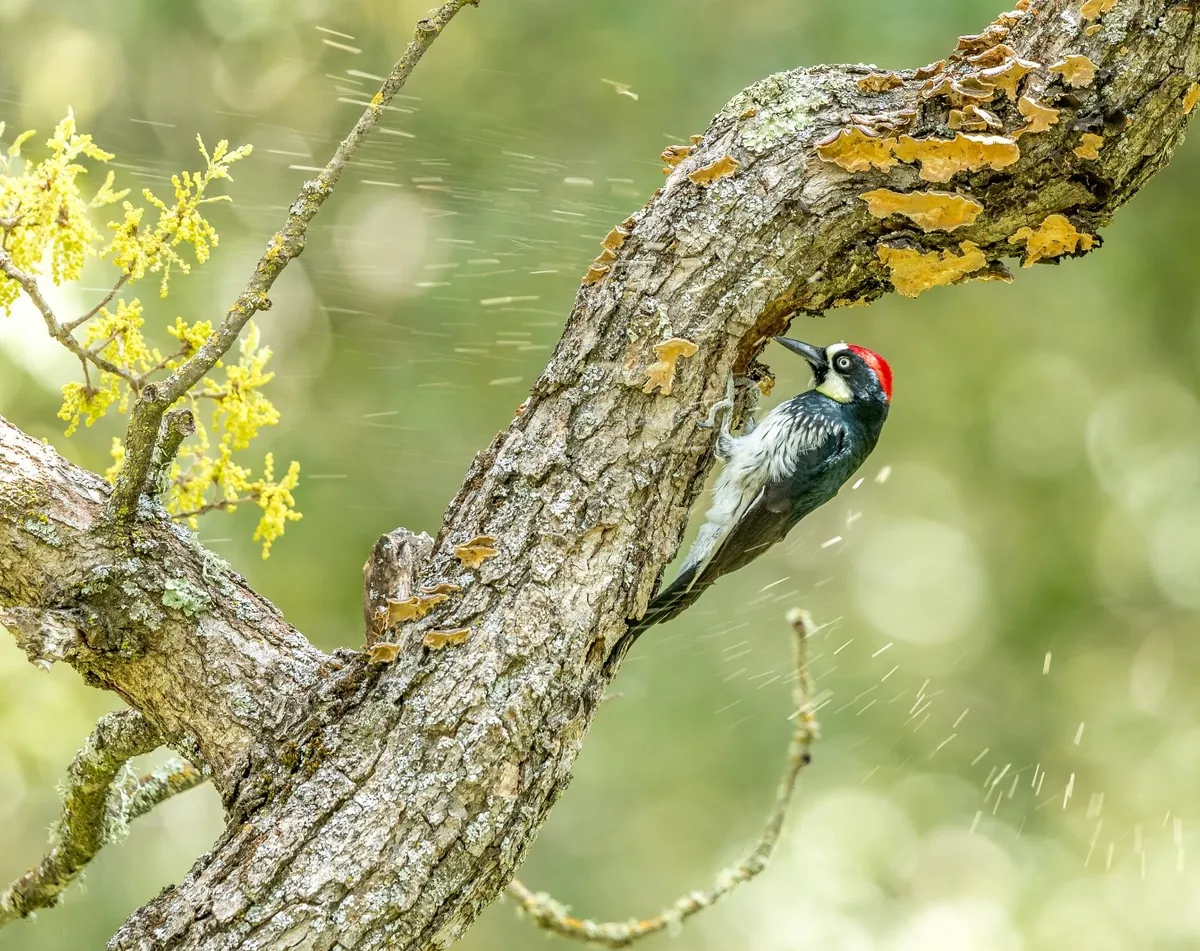Beneath the familiar drumming and flashing colors of woodpeckers lies one of nature’s most sophisticated infrastructure systems—a hidden network of engineered habitats that connects forest canopies to prairie flowers, supports over 35 species of wildlife, and generates billions in ecosystem services. This invisible architecture, created through the relentless excavation work of just seven Pennsylvania woodpecker species, functions as the foundational infrastructure for entire ecological communities, with surprising connections extending all the way to the goldenrod corridors blooming in forest edges and meadows.
Research reveals that 90% of all forest nesting cavities are woodpecker-created rather than naturally formed, making these birds the primary architects of forest housing infrastructure. Even more remarkably, scientists have discovered intricate resource trade routes connecting woodpecker engineering activities to goldenrod plant communities—relationships so subtle they’ve remained largely hidden from view until recent ecological detective work began mapping these invisible connections.
The wonder of biological infrastructure
When we think of infrastructure, we typically envision roads, bridges, and buildings constructed by human engineers. But woodpeckers operate as biological infrastructure specialists, creating architectural systems that rival human engineering in both complexity and longevity. A single pileated woodpecker pair, working with the persistence of skilled craftsmen, excavates cavities measuring 21 centimeters wide and 51 centimeters deep—custom-built housing that will serve wildlife communities for up to 18 years after construction.
The scope of their construction projects is staggering. Pennsylvania’s forests host seven primary woodpecker species—from the diminutive downy woodpecker managing 4.1-hectare territories to the magnificent pileated woodpecker overseeing domains spanning up to 450 hectares. Collectively, these biological contractors create 1.7 to 5.5 cavities per hectare annually, establishing housing developments that support everything from flying squirrels and bats to wood ducks and owls.
What makes this infrastructure truly remarkable is its cascading multiplier effect. Research demonstrates that secondary cavity nesters achieve 60-80% nesting success rates in woodpecker-created cavities compared to just 20-40% in open nests. These aren’t simply holes in trees—they’re precisely engineered structures with thermal regulation properties, predator protection features, and strategic placement that would impress any architect.
But the most surprising discovery lies in how this forest infrastructure connects to seemingly unrelated plant communities, particularly the goldenrod corridors that paint Pennsylvania’s late-summer landscapes in brilliant yellow.
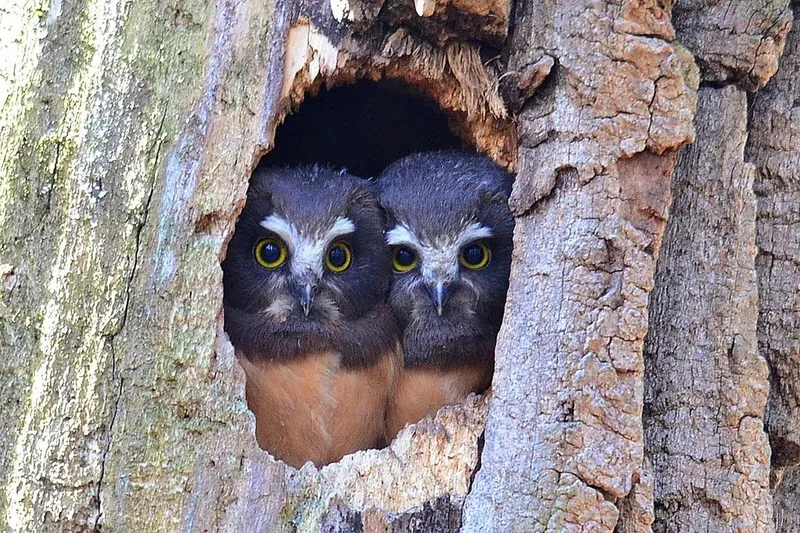
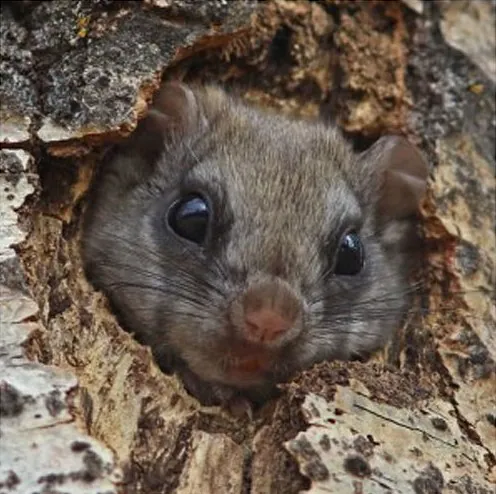
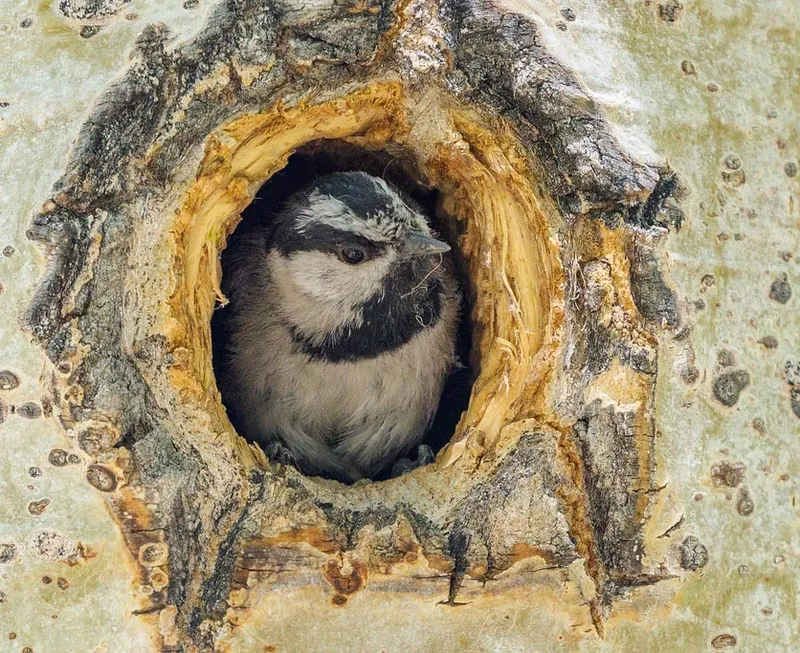
Hidden connections between canopy and corridor
The link between woodpecker excavations and goldenrod health unfolds through invisible pest control networks that operate like a sophisticated biological management system. When hairy woodpeckers systematically remove bark from ash and elm trees, they’re not just foraging—they’re eliminating up to 85% of wood-boring beetle larvae that would otherwise weaken trees and stress surrounding plant communities. This pest control service creates a cascade of benefits that flows directly to goldenrod stands growing in nearby forest edges and clearings.
The connection operates through multiple channels. Woodpeckers targeting insect-rich areas create territories where overall ecosystem health improves, supporting more robust plant communities including goldenrod populations. The relationship becomes even more direct during winter months, when downy woodpeckers specifically target goldenrod gall flies—protein-rich larvae overwintering inside Solidago stems. Using specialized pecking techniques, these birds extract the flies through precise entry points, providing targeted pest control services to goldenrod populations while securing high-energy winter nutrition.
This creates a fascinating resource trade route: goldenrod plants provide essential winter protein sources for woodpeckers when insects become scarce, while woodpeckers deliver year-round pest control services that promote healthier, more prolific goldenrod blooms. Late-summer goldenrod flowers, in turn, support monarch butterflies and other pollinators during critical migration periods, extending the ecosystem benefits far beyond the original woodpecker-plant interaction.
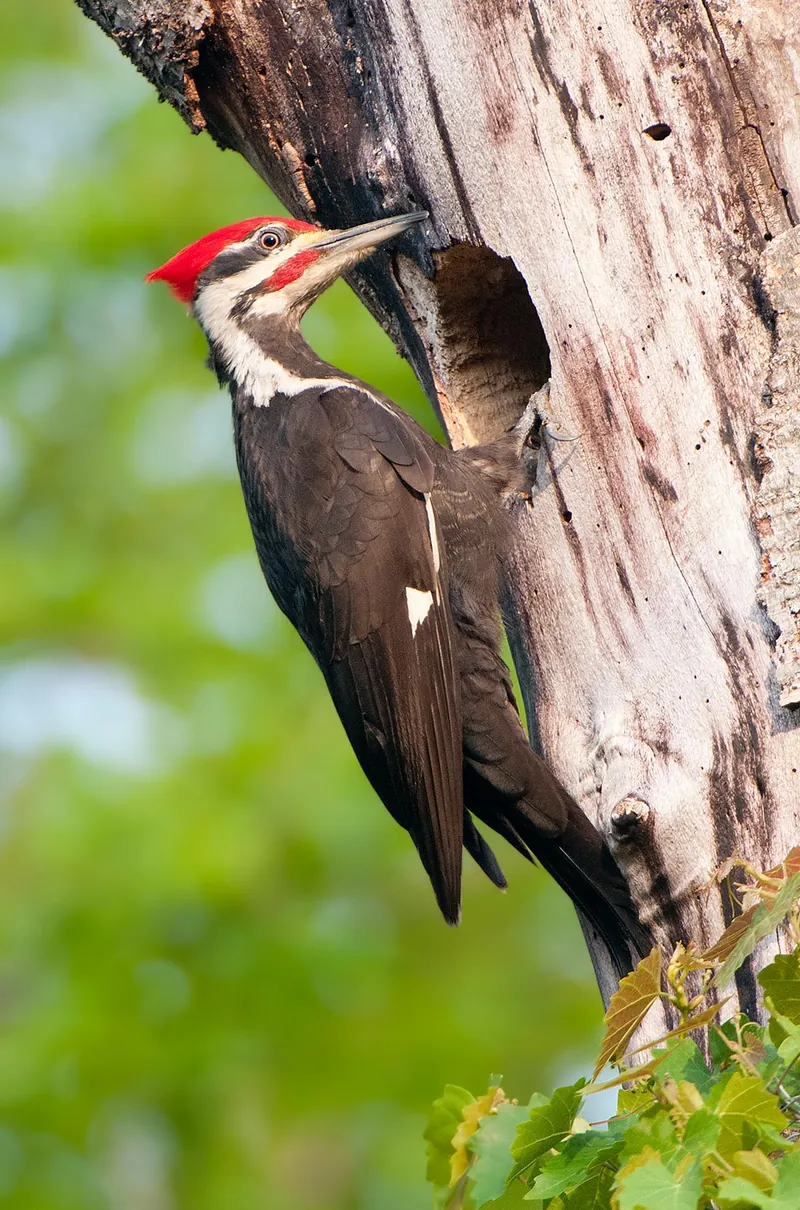
The underground economy of dead wood
Woodpecker engineering creates a hidden underground economy centered on strategic dead wood management and nutrient cycling that directly benefits goldenrod communities. When pileated woodpeckers excavate cavities or strip bark during foraging, they accelerate wood decomposition processes through mechanical breakdown and exposure to fungal colonization. This dead wood becomes a carbon and nitrogen bank that releases nutrients into surrounding soil through mycorrhizal networks connecting decomposing logs to living plant root systems.
Research quantifies this hidden economy: dead wood decomposition contributes 20% of forest carbon cycling, with nutrients becoming available to nearby plant communities including goldenrod stands. The fungal species colonizing woodpecker-created dead wood extend mycelial networks that transfer nitrogen and carbon directly from decomposing logs to goldenrod root systems, creating invisible nutrient highways spanning dozens of meters.
The timing of these nutrient releases synchronizes beautifully with goldenrod growth cycles. Spring nutrient pulses from decomposing wood support early season growth, while slower-release compounds fuel the energy-intensive process of late-summer bloom production. This underground support system helps explain why goldenrod stands often thrive in areas with high woodpecker activity and abundant dead wood—they’re literally connected through this hidden nutrient network.
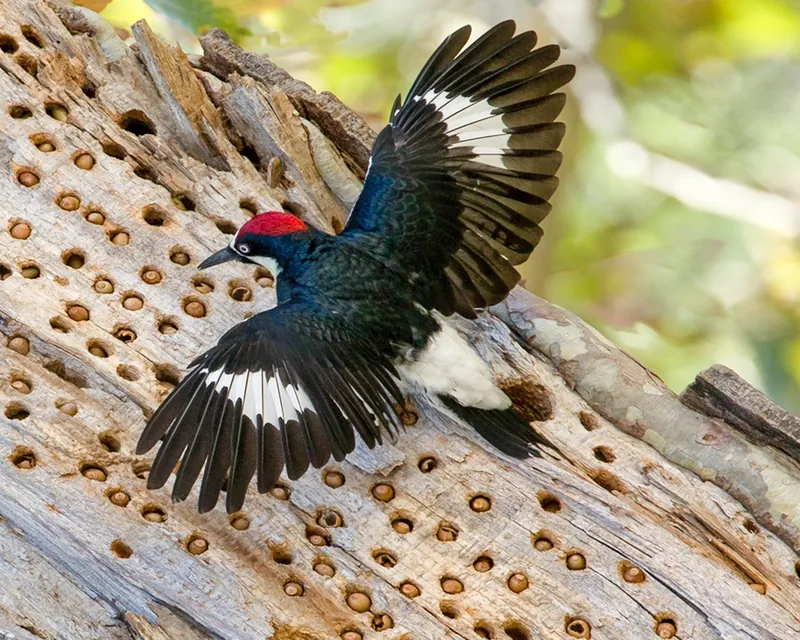
Woodpeckers also store acorns in tree bark, which also support other species by providing food storage and dispersing seeds
Seasonal synchrony and resource scheduling
The woodpecker-goldenrod system operates on precisely timed seasonal schedules that maximize resource sharing across multiple species. During breeding season (March through July), woodpeckers focus intensive foraging efforts on controlling wood-boring insects, bark beetles, and caterpillars. This pest control peak coincides with the critical growing period for goldenrod, ensuring plants receive maximum protection during vulnerable early growth phases.
As summer progresses into fall, the relationship shifts to direct resource exchange. Goldenrod gall flies complete their life cycles inside plant stems just as woodpecker protein requirements increase for winter survival. The downy woodpecker’s specialized foraging technique—precisely targeting the exit tunnels of gall flies—demonstrates remarkable adaptation to this seasonal resource opportunity.
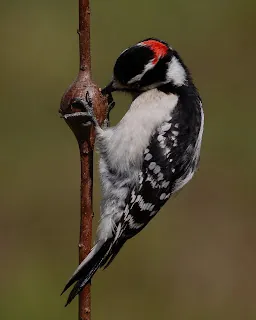
Winter reveals the full extent of the partnership. While goldenrod seed heads provide nutrition for finches, siskins, and juncos, the spent stems shelter overwintering gall fly larvae that sustain woodpeckers through lean months. Standing goldenrod structures also create microhabitat diversity that supports invertebrates woodpeckers consume, while persistent seed heads provide backup food sources during harsh weather periods when normal foraging becomes difficult.
Spring brings the cycle full circle as woodpeckers return to intensive territory establishment and cavity excavation, creating new housing infrastructure while renewed plant growth begins another year of this intricate partnership.
Multi-species housing developments and their residents
Woodpecker territories function as multi-species housing developments with remarkable occupancy patterns that extend benefits far beyond the original excavators. A single abandoned pileated woodpecker cavity becomes a sequential housing resource used by different species across multiple seasons and years. Research documents cavity reuse patterns lasting up to 18 years, with 49% of large cavities experiencing sequential occupancy by species ranging from wood ducks and flying squirrels to various owl species and bats.
The housing quality these biological developers provide surpasses natural alternatives in critical ways. Woodpecker-excavated cavities feature smaller entrance holes and deeper chambers than naturally formed decay cavities, providing superior thermal regulation and predator protection. Winter observations reveal the thermal value—up to 19 flying squirrels have been recorded sharing a single cavity for communal warmth, demonstrating how woodpecker architecture creates energy-efficient heating solutions for wildlife communities.
‘All of our secondary cavity nesters had higher success in abandoned woodpecker cavities than in cavities formed by decay’ Secondhand homes: The multilayered influence of woodpeckers as ecosystem engineers by Faith O Hardin, Samantha Leivers, Jacquelyn K Grace, Zachary Hancock, Tyler Campbell, Brian Pierce, Michael L Morrison
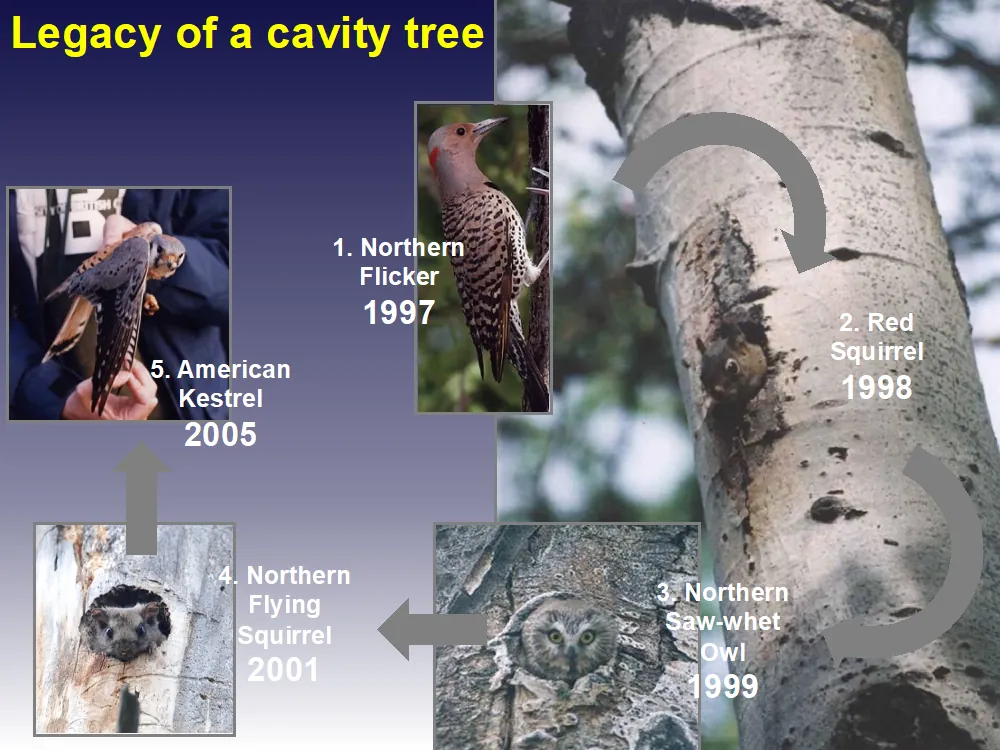
This housing infrastructure operates at landscape scales that connect forest patches through cavity networks. Secondary cavity nesters using woodpecker-created housing achieve reproductive success rates 2-3 times higher than species dependent on natural cavities, creating population sources that support surrounding areas. The cavity networks function as genetic highways maintaining gene flow for species across fragmented landscapes while providing critical stopover sites for migratory species.
Pennsylvania’s seven woodpecker species create specialized housing for different markets—from downy woodpecker apartments suitable for small songbirds to pileated woodpecker mansions accommodating wood ducks and large mammals. This diverse housing portfolio supports approximately 35 of Pennsylvania’s 190 breeding bird species, representing nearly 20% of the state’s avian biodiversity dependent on woodpecker infrastructure services.
Economic engines hidden in plain sight
The economic value generated by woodpecker ecosystem engineering operates as a hidden economic engine providing services worth hundreds of millions annually through pest control, biodiversity support, and climate resilience benefits. Research quantifies direct pest control services from woodpeckers and their secondary cavity-nesting tenants at $13-$53 per hectare annually in agricultural settings, with additional forest health benefits valued at $159-$650 per hectare in managed landscapes.
The economic multiplier effects extend well beyond direct services. Woodpecker territories support secondary cavity-nesting species that provide additional pest control, pollination, and seed dispersal services. The goldenrod connections add another economic layer—late-season blooms support monarch butterfly migrations worth millions in ecotourism revenue while providing critical pollination services for other economically valuable plants.
Climate change amplifies these economic benefits as woodpeckers become increasingly important for ecosystem resilience services. Their pest control capabilities help forests withstand increased insect pressure from climate stress, while their cavity infrastructure provides wildlife with refugia during extreme weather events. Dead wood management accelerates carbon cycling and nutrient availability, supporting forest adaptation to changing precipitation and temperature patterns.
Carbon sequestration benefits from woodpecker-influenced forest management range from 0.5-2.3 tons CO2 per hectare annually, while the biodiversity conservation value of their ecosystem engineering reaches $44-$198 per hectare based on species richness enhancements. These quantified benefits make woodpecker conservation a high-return investment in natural climate solutions.
Practical applications for landscape architects
Creating landscapes that support woodpecker ecosystem engineering while enhancing goldenrod corridors requires specific, research-backed strategies operating at multiple scales. For residential properties, the approach centers on integrated dead wood and native plant management. Homeowners should retain 2-4 snags per half-acre where safety permits, create brush piles from pruned materials, and establish native plant gardens featuring Pennsylvania goldenrod species like gray goldenrod (Solidago nemoralis) for dry sites and Canada goldenrod (S. canadensis) for mesic areas.
Property-level integration requires seasonal timing coordination. The optimal management window runs from September through February, avoiding critical March-August woodpecker nesting periods. During this window, landowners can create artificial snags by topping less desirable trees, establish goldenrod plantings in unmowed areas, and install brush structures that provide foraging substrate for both woodpeckers and goldenrod-dependent insects.
Landscape-scale approaches demand coordination across larger areas to create functional habitat networks. Research supports designing 15-25% of landscapes as diverse habitat mosaics combining mature forest stands with 8-15 snags per hectare, open woodland areas with 40-60% canopy cover supporting goldenrod establishment, and transitional edge habitats providing structural complexity. Connectivity corridors should span 50-100 meters wide incorporating both woody and herbaceous components while maintaining 3-8% of forested areas in permanent openings.
Municipal and institutional land managers can integrate these strategies with existing infrastructure. Stormwater management areas become opportunities for native plant establishment, utility rights-of-way function as habitat corridors when planted with appropriate goldenrod species, and coordinated management across public and private lands creates landscape-level habitat networks through conservation easements and partnership programs.
The future of biological infrastructure
The woodpecker-goldenrod hidden system represents a model for understanding biological infrastructure that could inform both conservation strategies and human infrastructure design. As climate change intensifies ecosystem stresses, these natural infrastructure systems become increasingly valuable for their adaptive capacity and resilience benefits. Unlike human infrastructure that requires constant maintenance and eventual replacement, biological infrastructure systems like woodpecker-created cavity networks become more valuable over time as they develop complex resident communities and ecological relationships.
The discovery of these hidden connections between forest canopy engineers and prairie corridor plants illustrates how ecological systems operate through multi-scale, multi-seasonal partnerships that generate benefits far exceeding the sum of individual components. Understanding these connections enables land managers to design interventions that support entire ecological networks rather than managing species in isolation.
Future research directions should focus on quantifying the climate adaptation benefits these biological infrastructure systems provide, mapping similar hidden connections between other ecosystem engineers and plant communities, and developing management protocols that optimize multiple ecosystem services simultaneously. The woodpecker-goldenrod relationship may represent just one example of many such hidden systems operating beneath the surface of familiar landscapes.
The implications extend beyond wildlife conservation to fundamental questions about how we design human communities. If seven species of woodpeckers can create landscape-scale infrastructure supporting hundreds of other species while generating millions in ecosystem services, what principles from their biological architecture might inform more sustainable human infrastructure development? The answer may lie in recognizing that the most resilient systems—whether biological or human—succeed through creating beneficial connections between seemingly unrelated components, generating emergent properties that support thriving, interconnected communities.
As we face an uncertain environmental future, the hidden genius of woodpecker infrastructure offers both inspiration and practical guidance for building landscapes that work with natural systems rather than against them. The drumming in the forest canopy and the golden blooms in meadow edges are no longer separate phenomena—they’re part of a single, sophisticated system that has been operating beneath our notice, creating abundance through connection, resilience through diversity, and prosperity through partnership.
🔎 More Hidden Systems
If this fascinated you, explore other stories from The Hidden Systems that reveal the invisible infrastructures shaping our world:
Nature’s Living Networks:
- 🌱 The Hidden Networks Beneath Your Feet — Underground root systems that engineer landscapes and control climate
- 🌼 Golden Highways — How roadside “weeds” create continental wildlife corridors
Each reveals a hidden system that connects natural processes, technological innovation, and economic power—showing how invisible networks shape everything from ecosystem health to global commerce.
For your curiosity
- Woodpecker Ecology and Behavior - Cornell Lab of Ornithology
- “The Hidden Life of Trees” by Peter Wohlleben - Explore forest communication networks
- “Nature’s Best Hope” by Douglas W. Tallamy - Creating habitat in your own backyard
- Pennsylvania Audubon Society - State-specific bird conservation
- Home Grown National Park - Native plant landscaping
Sources
Woodpeckers: The Engineers of Ecosystems - American Forests
Woodpeckers, decay, and the future of cavity-nesting vertebrate communities worldwide - Frontiers in Ecology and the Environment
Woodpeckers: Ecosystem Engineers - Alberta Institute For Wildlife Conservation
Secondhand homes: The multilayered influence of woodpeckers as ecosystem engineers - PMC / Ecology and Evolution
Woodpeckers and other excavators maintain the diversity of cavity-nesting vertebrates - Journal of Animal Ecology
Woodpecker Biology - Internet Center for Wildlife Damage Management
Woodpeckers - Penn State Extension
Woodpeckers - Pennsylvania Game Commission
During the winter goldenrod galls are a source of food for birds - The Detroit News
Goldenrod: Not Just Another Pretty Face - Penn State Extension
Climate change, woodpeckers, and forests: Current trends and future modeling needs - PMC / Ecology and Evolution
Analysis: The Economic Value of Birds - Cornell Lab of Ornithology
Management Practices for Enhancing Wildlife Habitat - Penn State Extension
A review of tree-scale foraging ecology of insectivorous bark-foraging woodpeckers in North America - Forest Ecology and Management
The Pileated Woopecker as Ecosystem Engineer - USDA
The Hidden Life of an Ecosystem engineer - Princeton university
Woodpeckers and other excavators build a legacy of diversity - Animal Ecology in Focus
Secondhand homes: The multilayered influence of woodpeckers as ecosystem engineers - NIH
Still curious?
Want more fascinating explanations about the Secret Engines of the world? Subscribe to the RSS Feed.
